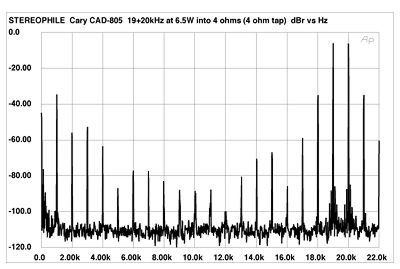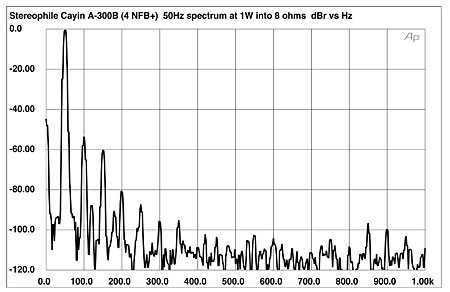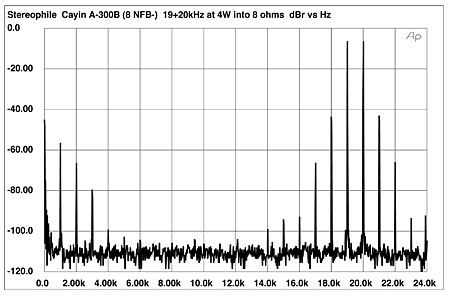Ed, these calculations don't look right.
By -45dB power distortion, do you mean 1 watt / 178 = 0.06 watts ?
No, he really means "(.00316% voltage distortion would be -45 db power distortion.)". You tell him, he won't believe me (no reason to, of course!).
Thanks,
Chris
Scott,
Well, one could carry out blind listening tests to establish distortion audibility.
Thankfully others have already done so repeatedly, so it may be expedient to avail oneself of their work, especially the one done by Geddes/Lee, others exist and have been cited also within this thread.
The basic upshot is that simple, low order distortion (e.g. that produces by Speakers or SE Tube Amplifiers) is practically inaudible until very high levels of distortion are reached and that distortion audibility is SPL dependent, higher SPL's tolerate greater levels of distortion.
If one happens to be from a Pro-Audio background, one may even remember the Aphex Exciter, which was basically a generator of gross distortion in certain audio frequency bands which made a system sound "louder" if used. The levels of distortion needed for this where in the tens of percent to get this effect...
All of the available evidence argues strongly that the kind of distortion present in for example Nelson Pass's Amplifiers (both Passlabs and Firstwatt) is inaudible under most conditions that do not clip the Amplifiers.
However, I would suggest that for example interaction with speakers distortion may cause results that are no longer inaudible due to a number of mechanisms.
Ciao T
How would one prove that the distortion spectra is not the difference?
Well, one could carry out blind listening tests to establish distortion audibility.
Thankfully others have already done so repeatedly, so it may be expedient to avail oneself of their work, especially the one done by Geddes/Lee, others exist and have been cited also within this thread.
The basic upshot is that simple, low order distortion (e.g. that produces by Speakers or SE Tube Amplifiers) is practically inaudible until very high levels of distortion are reached and that distortion audibility is SPL dependent, higher SPL's tolerate greater levels of distortion.
If one happens to be from a Pro-Audio background, one may even remember the Aphex Exciter, which was basically a generator of gross distortion in certain audio frequency bands which made a system sound "louder" if used. The levels of distortion needed for this where in the tens of percent to get this effect...
All of the available evidence argues strongly that the kind of distortion present in for example Nelson Pass's Amplifiers (both Passlabs and Firstwatt) is inaudible under most conditions that do not clip the Amplifiers.
However, I would suggest that for example interaction with speakers distortion may cause results that are no longer inaudible due to a number of mechanisms.
Ciao T
Hi Ed,
With respect, -46dB would be 0.5%, not 0.00316%.
Attached is a Trace from a JBL 4410 Studio Monitor (http://www.jblpro.com/pub/obsolete/4410.pdf), which I would suggest is reasonably analogue for a large size domestic HiFi Speakers (with a vented 10" Bass, 5" Cone Mid, 1" Dome Tweeter), though distortion is lower than HiFi Speaker average and SPL @ 2.83V/1m is lower:
This measurement is made at around -11dB (or 1/12) of full power. We get approximatly:
It is also worth noting that this Speakers shows around 1-2dB compression between 85dB & 105dB @ 1m, or in other words around 2dB compression @ 30W or one quarter of rated power.
I believe these measurements speak for themselves.
Ciao T
Here is a really lousy image I got from JBL. The distortion levels are raised by 20 db to make it easier to see them. Second and third are shown. They are around 45 db down from the test level of 2.83 volts input, nominal 1 watt. Measurement is at 1 meter. Level is calibrated or around 96 db spl.
Distortion is down by about 45 db re power. As amplifier distortion is often given as % of output voltage, be sure to include that! (.00316% voltage distortion would be -45 db power distortion.)
With respect, -46dB would be 0.5%, not 0.00316%.
Attached is a Trace from a JBL 4410 Studio Monitor (http://www.jblpro.com/pub/obsolete/4410.pdf), which I would suggest is reasonably analogue for a large size domestic HiFi Speakers (with a vented 10" Bass, 5" Cone Mid, 1" Dome Tweeter), though distortion is lower than HiFi Speaker average and SPL @ 2.83V/1m is lower:
An externally hosted image should be here but it was not working when we last tested it.
This measurement is made at around -11dB (or 1/12) of full power. We get approximatly:
Code:
20Hz -10dB 31.60%
50Hz -33dB 2.20%
100Hz -36dB 1.50%
500Hz -46dB 0.50%
1KHz -53dB 0.22%
5KHz -39dB 1.10%
10KHz -37dB 1.40%
20KHz -46dB 0.50%It is also worth noting that this Speakers shows around 1-2dB compression between 85dB & 105dB @ 1m, or in other words around 2dB compression @ 30W or one quarter of rated power.
I believe these measurements speak for themselves.
Ciao T
This is IMHO very well said. THD and IMD measurements cover very long time period of settled non-changing signal. The ear is most sensitive to transients, to the rising part of transients. Thus the methodology of THD and IMD is wrong regarding human perception. And it does not explain differences in sound of amplifiers at all, as the speaker distortion is about 20x higher at any level than that of well engineered solid state amplifier. Only some tube amps and poorly designed solid state have higher non-linear distortion than the speaker.
The only reason why THD/IMD is so popular is that it is easy to measure. Engineers love simple measurements that can be simply evaluated and compared. But, the ear is the judge and engineers tend to overlook principles of human hearing, or they rather do not know it at all and simply do not care. They usually use the equation lowest THD = best amp. Not many changes since 1970-ties.
Good post, PMA. To get closer to aim, sometimes we have to make a step aside from the mainstream, first as an idea, and second by developing a new measurement approach.
IMHO, sound becomes "lifeless" not due to some distortions of big signal constituents, but due to complete "loss" of some smallest signal components, at a level of microvolts. The "losses" mean that some tiny level information, present in initial signal in good recordings, are filtered-out by an amp (some tiny signal spikes, superimposed onto main signal components, do not survive at amp's output). This point of view aims us at materials science, parts effects, NFB and EMI effects, noise aspects, rather than in further "perfectioning" of schematics layouts by simulations.
This point of view, however, is of minor importance for devices being developed for technical (non-audio) applications. Therefore, experienced engineers, who got custom to work with clearly formulated technical assignments, do not understand what audiophiles want, since the last can not formulated technical assignment in terms of measurement techniques used and measured parameters achieved.
Last edited:
An externally hosted image should be here but it was not working when we last tested it.
Interesting the bump in H2 around 500Hz. Crossover is stated as 800Hz, so that may be part of what going on there.
The basic upshot is that simple, low order distortion (e.g. that produces by Speakers or SE Tube Amplifiers)
Really?

Both speakers and tube SE power amplifiers produce high order harmonics up to almost infinity, just decaying with frequency. And even the high order components are much higher in amplitude than those of well designed solid state amplifiers.
An example of SE tube amplifier is Cyain A-300B. Measurements are published of HD 1kHz/1W/8ohm and IMD 19+20kHz 4Wpeak/8ohm. Though the HD would be most probably inaudible, the IMD would be certainly audible and is above IMD distortion of a modern speaker. IMD spectral components are high up to the 6th harmonic, a proof that 'low order' distortion of SE tube amps is a myth.




Last edited:
Apart from what the harmonics add to the sound, they almost do not play in the subject "life-like" or "life-less" sound. Any amp, including SE tube amps with various harmonics spectra, can sound lifeless, depending on the factors, about which we are awared only empirically, almost without measurements support.
7th and 9th are the killers of good sound.
You can see them here easily:
http://www.diyaudio.com/forums/anal...ch-preamplifier-part-ii-1822.html#post2791904
But even the 2nd, 4th and 6th of IMD of the SE Cayin would be audible. The 2nd (difference tone 1kHz) will be certainly more audible for human ear than 19 and 20kHz test tones. The same for 4th and 6th, again low frequency products. They would 'colorize' more than the speaker.
Apart from what the harmonics add to the sound, they almost do not play in the subject "life-like" or "life-less" sound.
Agreed.
Lightning rods for audio?
How open are you to radical ideas? This is a real test of the open mind: Walker Audio Announces Release of All-New Eliminator Directional Antennae | AVguide
The basic principle is questionable at best and the implementation defies any understanding of electromagnetic radiation. However they are solid silver so they must be good. . .
(I guess my mind is not so open after all.)
How open are you to radical ideas? This is a real test of the open mind: Walker Audio Announces Release of All-New Eliminator Directional Antennae | AVguide
The basic principle is questionable at best and the implementation defies any understanding of electromagnetic radiation. However they are solid silver so they must be good. . .
(I guess my mind is not so open after all.)
Speaker Distortion?
There are quite a few detailed speaker measurements here:Welcome to www.SoundStageAV.com
Looking through the measurements two things occurred to me (without doing a methodical analysis). First frequency response doesn't seem to correlate to high praise among the press or the markets and the second is that low distortion does seem to correlate with the accepted "best" speakers. Even some speakers with genuinely bad response seem to have unusually low distortion and good subjective reviews.
There are quite a few detailed speaker measurements here:Welcome to www.SoundStageAV.com
Looking through the measurements two things occurred to me (without doing a methodical analysis). First frequency response doesn't seem to correlate to high praise among the press or the markets and the second is that low distortion does seem to correlate with the accepted "best" speakers. Even some speakers with genuinely bad response seem to have unusually low distortion and good subjective reviews.
7th and 9th are the killers of good sound.
Thats why a well designed SS amp will always be the most transparent - by the time you get the 7th and the 9th, they're probably down about 130db or more.
- Status
- Not open for further replies.
- Home
- Member Areas
- The Lounge
- John Curl's Blowtorch preamplifier part II